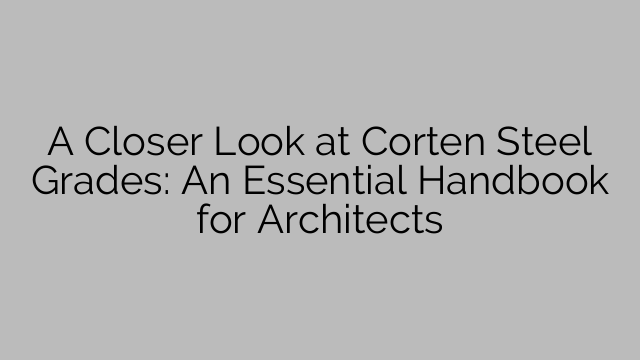When it comes to building materials, architects and designers are always on the lookout for unique and innovative options. One material that has gained significant popularity in recent years is Corten steel. Known for its distinctive weathered look and exceptional durability, Corten steel has become a popular choice for architects looking to create stunning and long-lasting structures.
But what exactly is Corten steel, and why are architects so enamored with its various grades? In this essential handbook, we’ll take a closer look at Corten steel grades, their properties, and how they can be effectively used in architectural design.
Corten steel, also known as weathering steel, is a group of steel alloys that were developed to eliminate the need for painting. Unlike traditional steel, which deteriorates over time when exposed to the elements, Corten steel forms a protective layer of rust when exposed to moisture, effectively preventing further corrosion. This unique property is what makes Corten steel an ideal material for outdoor installations and architectural projects.
One of the primary factors to consider when working with Corten steel is the choice of grades. Different grades offer unique properties and characteristics, ensuring that architects can select the most suitable option for their specific project requirements.
The most common grades of Corten steel are Corten A and Corten B. Corten A is known for its superior weather resistance and minimal maintenance requirements. It is commonly used in outdoor sculptures, façades, and landscape design. On the other hand, Corten B contains a higher percentage of copper, offering increased corrosion resistance. Architects often choose Corten B for applications exposed to harsher environments, such as bridges and industrial buildings.
Apart from Corten A and Corten B, there are other lesser-known grades of Corten steel, each with its own unique properties. Corten steel grade S355J0WP, for example, is specifically designed to withstand extreme weather conditions and is commonly used in coastal areas or regions with high humidity.
Another interesting grade is Corten steel grade S355J2W, which offers excellent welding and forming capabilities. Architects and designers appreciate this grade for its versatility, as it allows for complex and intricate architectural designs.
When selecting the right Corten steel grade for a project, architects must carefully consider factors such as the intended use, location, and exposure to different weather conditions. Consulting with experienced engineers and fabricators is crucial to ensure that the chosen grade will meet all the necessary requirements.
It is important to note that while Corten steel is highly durable and requires minimal maintenance, its installation and maintenance must be carried out correctly. Proper installation techniques and periodic cleaning procedures should be followed to ensure the longevity and sustainability of the structure.
In conclusion, Corten steel grades offer architects a unique blend of aesthetic appeal and durability. The distinct weathered look and exceptional corrosion resistance make it an excellent choice for outdoor installations and architectural design. By carefully selecting the appropriate Corten steel grade, architects can create structures that not only stand the test of time but also make a bold and lasting impression. With an ever-expanding range of Corten steel grades available today, architects have a plethora of options to choose from, ensuring that their designs are both functional and visually striking.
[anúncio_2]

